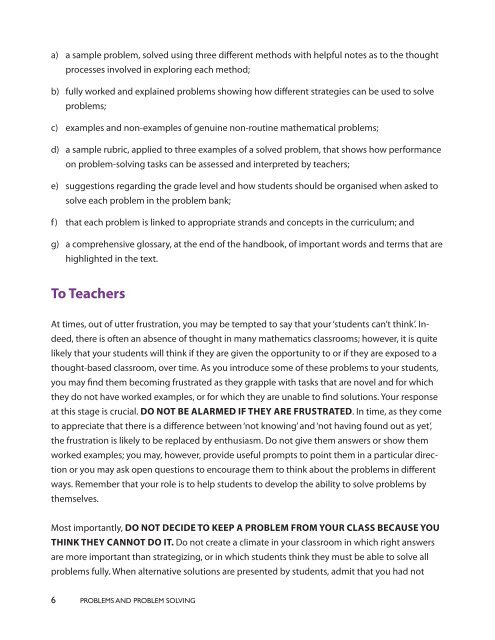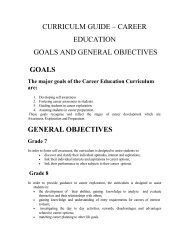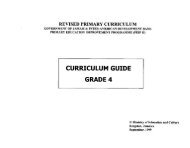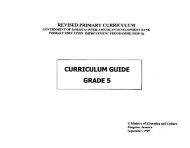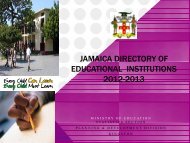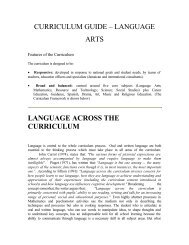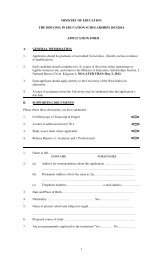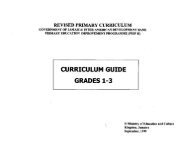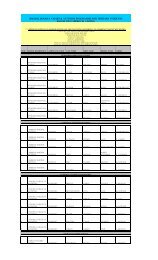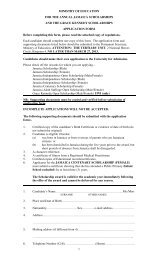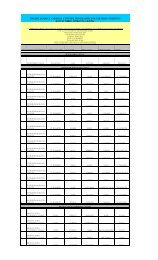Problems and Problem Solving - Ministry of Education
Problems and Problem Solving - Ministry of Education
Problems and Problem Solving - Ministry of Education
Create successful ePaper yourself
Turn your PDF publications into a flip-book with our unique Google optimized e-Paper software.
a)<br />
b)<br />
c)<br />
d)<br />
e)<br />
f)<br />
g)<br />
a sample problem, solved using three different methods with helpful notes as to the thought<br />
processes involved in exploring each method;<br />
fully worked <strong>and</strong> explained problems showing how different strategies can be used to solve<br />
problems;<br />
examples <strong>and</strong> non-examples <strong>of</strong> genuine non-routine mathematical problems;<br />
a sample rubric, applied to three examples <strong>of</strong> a solved problem, that shows how performance<br />
on problem-solving tasks can be assessed <strong>and</strong> interpreted by teachers;<br />
suggestions regarding the grade level <strong>and</strong> how students should be organised when asked to<br />
solve each problem in the problem bank;<br />
that each problem is linked to appropriate str<strong>and</strong>s <strong>and</strong> concepts in the curriculum; <strong>and</strong><br />
a comprehensive glossary, at the end <strong>of</strong> the h<strong>and</strong>book, <strong>of</strong> important words <strong>and</strong> terms that are<br />
highlighted in the text.<br />
To Teachers<br />
At times, out <strong>of</strong> utter frustration, you may be tempted to say that your ‘students can’t think’. Indeed,<br />
there is <strong>of</strong>ten an absence <strong>of</strong> thought in many mathematics classrooms; however, it is quite<br />
likely that your students will think if they are given the opportunity to or if they are exposed to a<br />
thought-based classroom, over time. As you introduce some <strong>of</strong> these problems to your students,<br />
you may find them becoming frustrated as they grapple with tasks that are novel <strong>and</strong> for which<br />
they do not have worked examples, or for which they are unable to find solutions. Your response<br />
at this stage is crucial. Do not be alarmed if they are frustrated. In time, as they come<br />
to appreciate that there is a difference between ‘not knowing’ <strong>and</strong> ‘not having found out as yet’,<br />
the frustration is likely to be replaced by enthusiasm. Do not give them answers or show them<br />
worked examples; you may, however, provide useful prompts to point them in a particular direction<br />
or you may ask open questions to encourage them to think about the problems in different<br />
ways. Remember that your role is to help students to develop the ability to solve problems by<br />
themselves.<br />
Most importantly, do not decide to keep a problem from your class because you<br />
think they cannot do it. Do not create a climate in your classroom in which right answers<br />
are more important than strategizing, or in which students think they must be able to solve all<br />
problems fully. When alternative solutions are presented by students, admit that you had not<br />
6 PROBLEMS AND PROBLEM SOLVING<br />
<strong>Problem</strong><strong>Solving</strong>.indd 6<br />
8/24/12 6:55:32 PM


